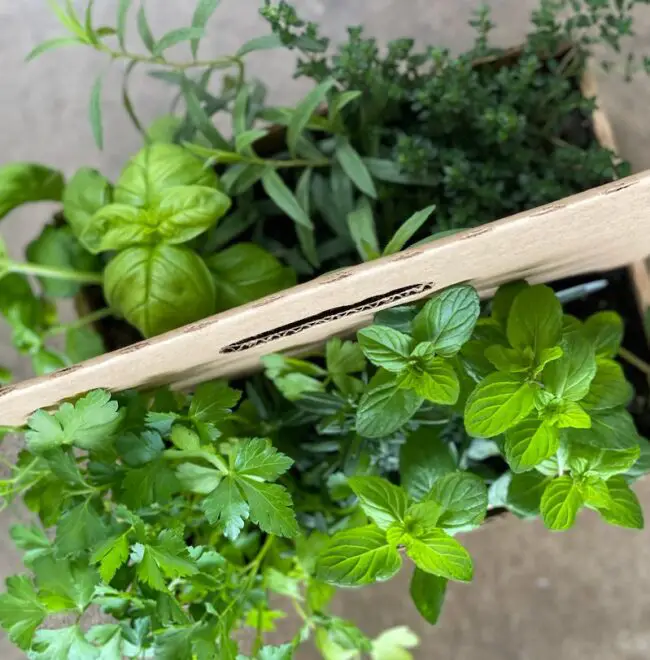Can you plant lemon balm and cilantro together? Absolutely! Combining the aromatic and flavorful lemon balm with the zesty and fresh cilantro can create a dynamic duo in your garden. Not only do they provide a burst of fragrance and taste, but they also have various health benefits. Lemon balm is known for its calming properties, while cilantro adds a punch of antioxidants.
By planting these herbs side by side, you can enjoy a delightful mix of scents and flavors while reaping the rewards of their medicinal qualities.
So, let’s dive into the details of planting lemon balm and cilantro together and witness the magic they create in your garden.
Can You Plant Lemon Balm and Cilantro Together?
If you’re an avid gardener or simply enjoy growing your own herbs, you may be wondering if it’s possible to plant lemon balm and cilantro together. Lemon balm and cilantro are both popular herbs that can add unique flavors to a variety of dishes.
However, when it comes to planting these herbs together, there are a few things you need to consider.
In this article, we’ll explore the compatibility of lemon balm and cilantro, the benefits of companion planting, and some tips for successfully growing these herbs together.
Understanding Lemon Balm and Cilantro
Before we look into planting these two herbs together, let’s understand a little more about lemon balm and cilantro individually.
Lemon Balm
Lemon balm, scientifically known as Melissa officinalis, is a perennial herb that belongs to the mint family. It is characterized by its lemony scent and delicate flavor, making it a popular choice for herbal teas, desserts, and seasoning.
Lemon balm is known for its calming properties and is often used for medicinal purposes, such as reducing anxiety and promoting sleep.
Cilantro
Cilantro, also known as coriander or Chinese parsley, is an annual herb that comes from the Apiaceae family. It features bright green, feathery leaves and a distinct aroma and taste. Cilantro is widely used in various cuisines around the world, particularly in Mexican, Indian, and Southeast Asian dishes.
The leaves and seeds of cilantro have different flavors, with the leaves adding a fresh, citrusy taste to dishes and the seeds providing a warm, earthy flavor.
Benefits of Companion Planting
Companion planting is the practice of growing different plants together for their mutual benefits. When certain plants are grown in close proximity, they can enhance each other’s growth, deter pests, and improve overall garden health.
Now let’s explore the potential benefits of companion planting lemon balm and cilantro together:
Pest Control
One of the benefits of planting lemon balm and cilantro together is their ability to repel certain pests. Lemon balm has natural insect-repellent properties, particularly against mosquitoes and gnats. Cilantro, on the other hand, can help deter aphids, spider mites, and other pests that might damage neighboring plants.
By combining these two herbs, you can create a natural defense system that keeps unwanted pests at bay.
Enhanced Flavor
Another advantage of planting lemon balm and cilantro together is the potential for enhanced flavor in your dishes. Lemon balm’s lemony aroma and cilantro’s fresh, citrusy taste can complement each other when used in cooking.
By having both herbs readily available in your garden, you can easily add a burst of flavor to your favorite recipes.
Biodiversity and Soil Health
Having a diverse range of plants in your garden helps promote biodiversity, attracting beneficial insects and pollinators. Lemon balm and cilantro, with their colorful flowers, can attract bees, butterflies, and other pollinators that are essential for a thriving garden.
Additionally, companion planting can improve soil health by increasing nutrient uptake, balancing pH levels, and reducing soil erosion.
Planting Lemon Balm and Cilantro Together
Now that we’ve explored the benefits of companion planting lemon balm and cilantro, let’s delve into some tips for successfully growing these herbs together:
Choose the Right Location
When planning your herb garden, select a location that receives at least six hours of direct sunlight daily. Lemon balm and cilantro thrive in full sun but can tolerate partial shade. Ensure the area has well-draining soil to prevent waterlogged roots.
Soil Preparation
Before planting, prepare the soil by removing any weeds or debris and loosening it with a garden fork or tiller. Add organic matter, such as compost or well-rotted manure, to improve soil fertility and drainage. Aim for a slightly acidic to neutral pH level of 6.0-7.0.
Planting Technique
When it comes to planting lemon balm and cilantro, you have a couple of options:
1. Plant in Separate Containers: If you’re concerned about the aggressive growth of lemon balm, it’s best to plant it in a separate container. This prevents it from overshadowing the cilantro and taking over the garden bed.
2. Plant Together with Spacing: If you choose to plant lemon balm and cilantro in the same bed, ensure there is ample space between the two plants.
Lemon balm can spread vigorously, so leaving about 18 inches of space between each plant will prevent overcrowding.
Care and Maintenance
To ensure the health and productivity of your lemon balm and cilantro, follow these care tips:
– Watering: Lemon balm and cilantro prefer consistently moist soil. Water them deeply once or twice a week, depending on the weather conditions. Avoid overwatering, as this can lead to root rot.
– Mulching: Apply a layer of organic mulch, such as straw or wood chips, around the base of the plants. Mulching helps retain moisture, suppresses weed growth, and regulates soil temperature.
– Pruning: Lemon balm can become leggy if not pruned regularly. Trim back the stems by a third to encourage bushier growth. Cilantro can also benefit from pinching off the tips to prevent it from bolting (going to seed) too quickly.
Planting lemon balm and cilantro together can be a beneficial and flavorful addition to your herb garden. These herbs offer natural pest control, enhanced flavor, and contribute to overall garden health.
By following the recommended planting techniques and care tips, you can enjoy a thriving garden filled with the refreshing scents and tastes of lemon balm and cilantro.
Remember to experiment with different combinations of herbs and vegetables to discover your own unique, culinary garden.
So go ahead, plant some lemon balm and cilantro, and elevate your gardening experience with this dynamic duo!
Frequently Asked Questions (FAQs)
Yes, lemon balm and cilantro can be planted together as they complement each other well in terms of growth requirements and pest repelling properties.
Planting lemon balm and cilantro together can have several benefits. Lemon balm can attract beneficial insects such as bees and butterflies, while cilantro can repel harmful pests like aphids.
Additionally, both herbs can enhance the flavor of the dishes they are used in.
Lemon balm and cilantro have similar soil and sunlight requirements, making them suitable to be planted together.
They both prefer well-draining soil and thrive in full sun to partial shade.
Yes, lemon balm and cilantro can be planted in the same container. However, make sure to provide enough space for each plant to grow to their full potential.
Lemon balm and cilantro should be watered regularly when planted together.
Allow the top inch of soil to dry out between waterings, but ensure that the plants receive enough moisture to prevent wilting.
Lemon balm and cilantro generally have no negative interactions with other plants. However, they may compete for nutrients if planted too closely with other herbs or vegetables.
Lemon balm and cilantro can be planted together in various climates, but they have different preferences.
Lemon balm is more tolerant of heat and prefers warmer temperatures, while cilantro thrives in cooler climates. Both can be grown successfully with appropriate care and attention.
Lemon balm typically takes about 2 to 3 months to reach maturity, while cilantro can be harvested in around 3 to 4 weeks after planting.
However, it’s important to note that individual growth rates may vary depending on growing conditions and care.
Final Thoughts
Planting lemon balm and cilantro together can be a great idea as they complement each other well. Lemon balm adds a citrusy and refreshing flavor, while cilantro brings in a distinctive, herbaceous taste. Both herbs thrive in similar growing conditions, including full sun or partial shade and well-draining soil.
Additionally, planting them together can help repel pests and attract beneficial pollinators to your garden. Just ensure to provide enough space for each plant to grow and avoid overcrowding. Ultimately, planting lemon balm and cilantro together is a harmonious combination that can enhance the flavors and aesthetics of your garden or culinary creations.
Auto Amazon Links: No products found.
Perfect Plants Christmas Tree Saver 8oz. | Easy Use Xmas Tree Preserver Food | Have Healthy Green Christmas Trees All Holiday Season
$9.97 (as of December 13, 2025 05:07 GMT +00:00 - More info- Product prices and availability are accurate as of the date/time indicated and are subject to change. Any price and availability information displayed on [relevant Amazon Site(s), as applicable] at the time of purchase will apply to the purchase of this product.
Rocky Mountain Goods Christmas Tree Food - 8 oz Tree Preservative - Reduce Needle Drop - Greener Scent - Fir, Pine, Spruce Trees - Extend Tree Life
$9.95 (as of December 13, 2025 05:07 GMT +00:00 - More info- Product prices and availability are accurate as of the date/time indicated and are subject to change. Any price and availability information displayed on [relevant Amazon Site(s), as applicable] at the time of purchase will apply to the purchase of this product.
FirEver Pure Christmas Tree Food | Preserver Additive & Season Extender for Live Xmas Trees | Keep It Green, Reduce Needle-Drop | Miracle Freshness (8 oz)
$14.99 (as of December 13, 2025 05:07 GMT +00:00 - More info- Product prices and availability are accurate as of the date/time indicated and are subject to change. Any price and availability information displayed on [relevant Amazon Site(s), as applicable] at the time of purchase will apply to the purchase of this product.
VICAMB 39.3 Inch Christmas Tree Watering Funnel,Christmas Tree Watering System Device,Long Tree Watering Funnel Spout for Indoor Outdoor Xmas Tree
$16.99 (as of December 13, 2025 05:07 GMT +00:00 - More info- Product prices and availability are accurate as of the date/time indicated and are subject to change. Any price and availability information displayed on [relevant Amazon Site(s), as applicable] at the time of purchase will apply to the purchase of this product.
EZMeetU Christmas Tree Watering Funnel, 47 Inch Flower Shape Adjustable 6 Section Design, Christmas Tree Watering System, Christmas Tree Waterer, Long Funnel Wide Opening Reusable, Plant Watering Tool
$16.99 (as of December 13, 2025 05:07 GMT +00:00 - More info- Product prices and availability are accurate as of the date/time indicated and are subject to change. Any price and availability information displayed on [relevant Amazon Site(s), as applicable] at the time of purchase will apply to the purchase of this product.
Snow Joe Premium Enviro Blend Ice Melt, Green-Coated Deicer Crystals, 50 lb - Safer Melter for Vegetation, Concrete & Metals w/ Anti-Corrosion Calcium Magnesium Acetate
$32.97 (as of December 12, 2025 19:27 GMT +00:00 - More info- Product prices and availability are accurate as of the date/time indicated and are subject to change. Any price and availability information displayed on [relevant Amazon Site(s), as applicable] at the time of purchase will apply to the purchase of this product.
Muddy Mat® Shown on TV Super Absorbent Microfiber Dog Door Mat for Muddy Paws, Non-Slip Washable Pet Rug, Quick Dry Chenille Entryway Carpet, Machine Washable Indoor Outdoor mat, Grey 30"x19"
$24.95 (as of December 12, 2025 19:27 GMT +00:00 - More info- Product prices and availability are accurate as of the date/time indicated and are subject to change. Any price and availability information displayed on [relevant Amazon Site(s), as applicable] at the time of purchase will apply to the purchase of this product.
ivtivfu Rolling Grill Basket, Removable Wooden Handle, 304 Stainless Steel, Nesting BBQ Tools, Smoker Grilling Accessories for Vegetable, Outdoor Cooking Camping, Birthday Gifts for Men Dad Husband
$25.99 (as of December 12, 2025 19:27 GMT +00:00 - More info- Product prices and availability are accurate as of the date/time indicated and are subject to change. Any price and availability information displayed on [relevant Amazon Site(s), as applicable] at the time of purchase will apply to the purchase of this product.
XXXFLOWER Plant Terrarium with Wooden Stand, Air Planter Bulb Glass Vase Metal Swivel Holder Retro Tabletop for Hydroponics Home Garden Office Decoration - 3 Bulb Vase
$18.98 (as of December 12, 2025 19:27 GMT +00:00 - More info- Product prices and availability are accurate as of the date/time indicated and are subject to change. Any price and availability information displayed on [relevant Amazon Site(s), as applicable] at the time of purchase will apply to the purchase of this product.
Zevo Flying Insect Trap Official Refill Cartridges - Fits Both Zevo Trap & MAX Indoor Fly Trap - Authentic Trap+Lock Technology to Catch Gnats, House & Fruit Flys (4 Official Refill Cartridges)
$14.97 (as of December 12, 2025 19:27 GMT +00:00 - More info- Product prices and availability are accurate as of the date/time indicated and are subject to change. Any price and availability information displayed on [relevant Amazon Site(s), as applicable] at the time of purchase will apply to the purchase of this product.











